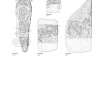Inverurie
Pictish Symbol Stone (Pictish)
Site Name Inverurie
Classification Pictish Symbol Stone (Pictish)
Alternative Name(s) Old Inverurie Churchyard; Inverurie Cemetery; Inverurie No. 2; Inverury No. 2
Canmore ID 18874
Site Number NJ72SE 11.02
NGR NJ 7802 2062
Datum OSGB36 - NGR
Permalink http://canmore.org.uk/site/18874
- Council Aberdeenshire
- Parish Inverurie
- Former Region Grampian
- Former District Gordon
- Former County Aberdeenshire
In 2018, Scheduled Monument Consent approved relocation of SM74 (four symbol stones) to within the grounds of SM99 (Bass and Little Bass Motte) and their housing within a glass case display.
The four Class I Pictish symbols stones were previously located 100m west northwest of their present location and are now in a glass display case on The Bass and Little Bass, motte-and-bailey castle (Scheduled Monument SM99). This is located within Inverurie Cemetery.
The stones are believed to have been previously built into the walls of the old parish church, which stood in the northwest corner of the adjacent cemetery. The kirk went out of use in 1775, its walls were used as a source to construct or repair the dykes of the kirkyard in the early 19th century. Three of the symbol stones were later removed from the dykes and while another was rescued when the walls were being constructed. The four symbol stones are now in a glass display case, known as and arranged (from left to right) as; Inverurie numbers 1, 2, 3 and 4.
Reference (1903)
(Inverury no. 2). A fragment of red granite, of rectangular shape, broken into two pieces across the middle, 2 ft (0.61m) long by 1ft 4ins (0.41m) wide, sculptured with incised lines (having the surfaces between them slightly rounded, so as to give somewhat the appearance of relief). Front: at the top the mirror-case symbol, and below it the horse-shoe symbol. The former is ornamented with arcs of circles, and the latter with double spirals having S-shaped connections.
J R Allen and J Anderson 1903.
External Reference (1980)
(Inverurie No. 2). This stone is of red granite, broken across the middle but the mirror case and horseshoe symbols are still visible. The piece measures 0.61m x 0.40m.
Information from R Jones 1980.
Field Visit (14 August 2000)
(Inverurie no. 2). The southernmost of the stones, the Class I symbol stone known as Inverurie no.2, is a fragment of a larger slab, which has been cut down for reuse as a building stone and is now lying upon the ground. A roughly square block of pink granite, it measures 0.32m high, 0.42m in breadth and 0.19m in thickness. The face bears portions of two incised symbols. The upper, at the top, is a mirror-case symbol, but only the lower half and its handle survive. Above the handle, the disk contains a concentric circle, around the edges of which curving lines give the impression of a petal-like pattern. The handle of the mirror-case, which has concave sides and a slightly concave base, is ornamented with curving lines and two hollows. Below the mirror-case, and its foot, is what at first appears to be the upper half of a large disk, filled with curvilinear ornament. However, the ornament is suggestive of a bilaterally symmetrical symbol, such as an arch, rather than one of the discoid symbols. The reverse of the stone is rough and irregular.
The close proximity of the two symbols has resulted in its interpretation as an unusually large and elaborately decorated mirror. It is illustrated as such in Allen and Anderson, although the text identifies the two symbols as a mirror-case and an arch.
Visited by RCAHMS (IF), 14 August 2000.
J R Allen and J Anderson 1903.




















